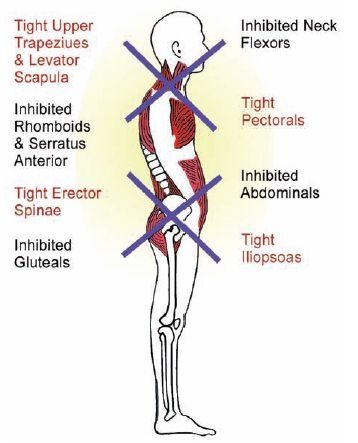Upper and Lower Cross Syndrome
This topic is one of the most interesting and important things that I talk to almost all of my patients about. When I usually bring it up, it's followed by a curious look of bewilderment . In short: Upper and lower cross syndromes are postural issues, but to leave it there is a significant disservice to the concept. 
Both Upper Cross Syndrome (UCS) and Lower Cross Syndrome (LCS) could be referred to as Modern Society Syndrome due to the numerous modern activities which are attributed with these pathologies. UCS and LCS can be aggravated by things such as Sitting, Computer use, Smart Phone use, etc. However, attributing these issues solely with a certain behavior only slightly covers the truth of the matter.
The major causes are actually a lack of a certain behavior, namely stretching and strengthening. As indicated in the Images above some muscle groups become tight while others are inhibited and loose. This concept of inhibited and restricted are at the core of LCS and UCS.
Starting at the top with UCS there are four main muscle groups involved. Pectoralis Major and Sub occipital muscles become tight and overworked, while the Deep neck flexors, and Rhomboids/ Scapular retractors are inhibited and unable to properly perform as antagonistic muscles to the aforementioned tight muscles. This imbalance is the primary issue at hand with Upper cross
and Lower cross syndrome.
LCS has a similar layout in the low back region. The Tight muscles involved are the Hip flexors and low back extensors, while the inhibited muscles are the abdominals and the glutes.
Next post I will be discussing the reasons why these muscles can cause so much distress.
Till next time!